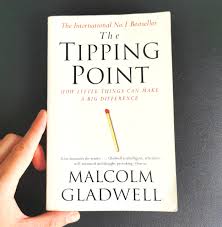The Tipping Point:
How Little Things Can Make a Big Difference

By Malcolm Gladwell
Originally published in 2000
304 pages
I read The Tipping Point soon after it was first published. It was a book about how social and cultural phenomena come about – and how values and mores change.
The author, Malcolm Gladwell, was interested in “big” issues like crime and racism and education. But he introduced his thesis with several simple examples, one of which was how “desert boots,” a shoe that was first produced in 1949, gradually expanded its market reach until it seemingly suddenly became enormously popular in the 1960s… had a revival in the 1970s… and, eventually, more than 10 million were sold.
As I said, the book was meant to be about social and cultural change. But for me, it was a brilliant insight into mass marketing, much like Robert Cialdini’s Influence: The Psychology of Persuasion.
What I Liked About It – and Why I’m Still Recommending It
The core idea – that trends start on the fringes of a social system and gradually move towards the center until, at one point, they explode in popularity – wasn’t entirely new to me.
But what The Tipping Point gave me was an explanation as to why, in every industry, dozens or even hundreds of competing businesses spend years and millions of dollars on marketing campaigns with similar themes that see similar results – and then, suddenly, one of those campaigns takes off like a rocket and leaves everyone else in the dust.
It also explained why so many creatives in marketing and advertising – copywriters, marketing directors, and campaign managers – are always complaining that their competitors are “knocking off” what they believe to be their original ideas.
And finally, it explained why, when marketing breakthroughs are achieved and the “geniuses” behind them are asked how they came up with the ideas, they don’t have good answers. It’s why many of them say it was just timing and luck.
Though I had been successfully marketing products and services for 25 years when I read the book, it changed the way I thought about marketplace competition and the true value of “great ideas.”
Since then, I’ve given dozens of speeches, written dozens of essays, and had hundreds of interactions with marketing people trying to explain the power of what Gladwell calls the “tipping point” – that it’s not the idea itself that is the secret of the phenomenal marketing success stories we are all familiar with. Because just before a marketing idea seems to explode out of nowhere, there are dozens or even hundreds of smart marketers testing out the very same idea.
Critical Reception
The reading public has loved everything that Gladwell has written, especially The Tipping Point, his first book. Often mentioned: his “journalistic curiosity,” “meticulous research,” and “engaging storytelling.” The critics, however, are not as enamored.
* “To the intelligentsia, Gladwell’s an oversimplifier on his very best day; on his worst, a conspiracy-theorizing spinner of mass delusion.” – Wired
* “Malcolm Gladwell… master of the let me take you by the hand prose style, dealer in the simple and unmistakable thesis…” – The Atlantic
Gladwell responded to such criticism in The Guardian, saying, “If my books appear to a reader to be oversimplified, then you shouldn’t read them: You’re not the audience!”
And as one critic noted in Slate Magazine: “[All of this criticism] brings me back to the question of why Gladwell matters so much. Why am I, an academic who is supposed to be keeping his head down and toiling away on inaccessible stuff for others to bring to light for the masses, spending so much time on reading Gladwell’s interviews, reviewing his book, and writing about him? I think that what Malcolm Gladwell says matters because, whether academics like it or not, he is incredibly influential.”
Here’s Gladwell doing a TED Talk about The Tipping Point. (Watch Time: 17 min.)
